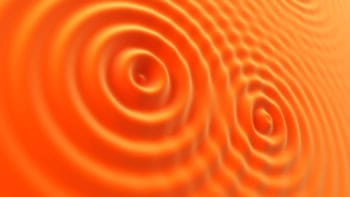Flash Physics is our daily pick of the latest need-to-know developments from the global physics community selected by Physics World‘s team of editors and reporters

Star deflects light just as Einstein predicted
The first observation of gravitational microlensing by a star other than the Sun has been reported by astronomers using the Hubble Space Telescope. Predicted by Albert Einstein as a consequence of his general theory of relativity, gravitational microlensing involves the gravitational field of a star bending light coming from a more distant star. It was first observed during a total eclipse in 1919 by looking for deflections in the positions of stars in parts of the sky next to the Sun. Now, Kailash Sahu of the Space Telescope Science Institute in the US and an international team have measured the gravitational lensing of a background star by a white dwarf star called Stein 2051 B. Because the background star is not lined-up perfectly with Earth and Stein 2051 B, a combination of gravitational lensing and Earth’s motion around the Sun causes the background star to appear to trace out a loop around Stein 2051 B. Sahu and colleagues mapped its position at five different times in 2013-14 and used this information to calculate the mass of Stein 2051 B. It turns out that astronomers have puzzled over the mass of the white dwarf for over 100 years. It is part of a binary system and the motion of its distant companion suggests that Stein 2051 B has a smaller mass than most white dwarfs, implying that it might have an exotic composition. This recent work, however, suggests that the star has a mass expected for a white dwarf of its radius. The observations will be described in and upcoming paper in Science.
Amorphous topological insulators are possible, calculations reveal
Some amorphous materials such as glasses could be topological insulators – a property that is normally associated with materials with atoms locked into regular crystal structures. That is the claim of Adhip Agarwala and Vijay Shenoy of the Indian Institute of Science in Bangalore, who have done calculations describing electron-like particles “hopping” between sites that are distributed randomly within a material. Agarwala and Shenoy found that some 2D and 3D materials could have conducting “edge states”, even though the materials are insulators in the bulk. This is a hallmark of topological insulators and normally arises because of certain properties of the electronic band structure that occurs in crystalline materials. In a paper in Physical Review Letters, the physicists say emergence of these states is associated with the presence of “spin-orbit motifs” in the materials. In real materials these motifs could be atoms, molecules or nanoclusters that support the interaction between the spin and orbital angular momentum of electron-like particles. They also say that it could be possible to engineer amorphous topological insulators by introducing impurities with the appropriate properties into an amorphous material.
Origin of the Tibetan Plateau comes under scrutiny

The Tibetan Plateau rose within 10 million years rather than 45 million years as previously thought, according to a comprehensive seismic study by geophysicists. The vast plateau in Asia covers an area of 2.5 million km2 and stands on average 4.5 km above sea level. It has long been thought that the so-called “Roof of the World” has been continuously rising since the Indian and Eurasian tectonic plates began colliding 45 million years ago. This leading theory says that the northward motion of the Indian plate forces the plateau to simultaneously shorten and rise. Now, however, geophysicists led by Min Chen of Rice University in the US propose a different scenario based on three years of seismic data and supercomputer modelling. Chen and colleagues looked at readings from thousands of stations in East Asia, where seismometers measure the amplitude and timings of seismic waves caused by tectonic movements. The researchers then used a technique called full waveform inversion, which involves using supercomputers to work backwards from the seismic data so as to calculate what rocks the waves had passed through. “The technique really allows us to use all the wiggles on a large number of seismographs to build up a more realistic 3-D model of Earth’s interior,” says Chen. The team now believes that the plateau rose dramatically during the first 10 million years of the India-Eurasia collision. Both plates were rigid and buoyant, and rather than one pushing under the other, the two came together to form a thick slab of lithosphere. The Eurasia plate, however, was more deformable, creating a denser portion of lithosphere that eventually sank and today extends at least 660 km below the plateau. “Our seismic image suggests that the Tibetan lithosphere thickened and formed a denser root that broke away and sank deeper into the mantle,” Chen explains, “We conclude that most of the uplift across Southern Tibet likely occurred when this lithospheric root broke away.” The new model is presented in Nature Communications.



